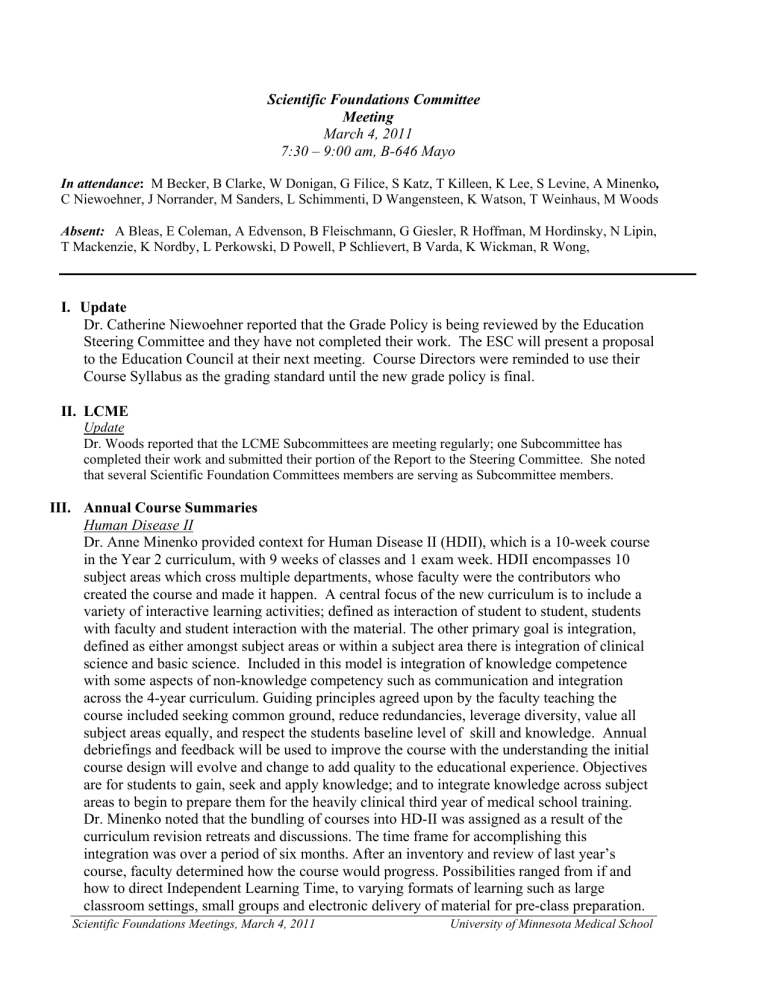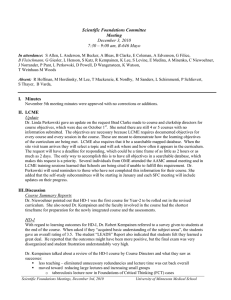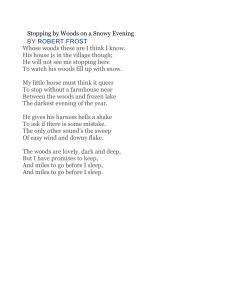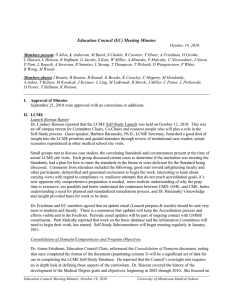Scientific Foundations Committee Meeting March 4, 2011

Scientific Foundations Committee
Meeting
March 4, 2011
7:30 – 9:00 am, B-646 Mayo
In attendance: M Becker, B Clarke, W Donigan, G Filice, S Katz, T Killeen, K Lee, S Levine, A Minenko ,
C Niewoehner, J Norrander, M Sanders, L Schimmenti, D Wangensteen, K Watson, T Weinhaus, M Woods
Absent: A Bleas, E Coleman, A Edvenson, B Fleischmann, G Giesler, R Hoffman, M Hordinsky, N Lipin,
T Mackenzie, K Nordby, L Perkowski, D Powell, P Schlievert, B Varda, K Wickman, R Wong,
I.
Update
Dr. Catherine Niewoehner reported that the Grade Policy is being reviewed by the Education
Steering Committee and they have not completed their work. The ESC will present a proposal to the Education Council at their next meeting. Course Directors were reminded to use their
Course Syllabus as the grading standard until the new grade policy is final.
II.
LCME
Update
Dr. Woods reported that the LCME Subcommittees are meeting regularly; one Subcommittee has completed their work and submitted their portion of the Report to the Steering Committee. She noted that several Scientific Foundation Committees members are serving as Subcommittee members.
III.
Annual Course Summaries
Human Disease II
Dr. Anne Minenko provided context for Human Disease II (HDII), which is a 10-week course in the Year 2 curriculum, with 9 weeks of classes and 1 exam week. HDII encompasses 10 subject areas which cross multiple departments, whose faculty were the contributors who created the course and made it happen. A central focus of the new curriculum is to include a variety of interactive learning activities; defined as interaction of student to student, students with faculty and student interaction with the material. The other primary goal is integration, defined as either amongst subject areas or within a subject area there is integration of clinical science and basic science. Included in this model is integration of knowledge competence with some aspects of non-knowledge competency such as communication and integration across the 4-year curriculum. Guiding principles agreed upon by the faculty teaching the course included seeking common ground, reduce redundancies, leverage diversity, value all subject areas equally, and respect the students baseline level of skill and knowledge. Annual debriefings and feedback will be used to improve the course with the understanding the initial course design will evolve and change to add quality to the educational experience. Objectives are for students to gain, seek and apply knowledge; and to integrate knowledge across subject areas to begin to prepare them for the heavily clinical third year of medical school training.
Dr. Minenko noted that the bundling of courses into HD-II was assigned as a result of the curriculum revision retreats and discussions. The time frame for accomplishing this integration was over a period of six months. After an inventory and review of last year’s course, faculty determined how the course would progress. Possibilities ranged from if and how to direct Independent Learning Time, to varying formats of learning such as large classroom settings, small groups and electronic delivery of material for pre-class preparation.
Scientific Foundations Meetings, March 4, 2011 University of Minnesota Medical School
Small group activities included clinical skill workshops, the CPC lab in Pathology, video viewing, case solving, the active learning classrooms (new building), audience response system with cases, and in Some subject areas there were live patients in the classroom. She explained that when possible lectures and/or activities were organized around common themes; i.e. trauma week, tumor week, sleep and snoring week, etc.
Dr. Minenko discussed a number aspects of the course structure throughout the 9 weeks of classes:
weekly pre and post integrated tests of the subject matter; Moodle based and auto corrected for immediate feedback
posting all materials for every session (lecture materials, readings, an outline)
objectives of each activity
explanation of what students would be doing in a session
what students were to do to prepare (hyperlinked to the actual chapter of pre-assigned readings)
activities were tagged with an “I” if it was to interactive
Dr. Minenko also provided details for how assessments were structured which included the final exam worth 60% of the course grade; take-home assignments worth 20% and small group attendance was worth 20%. The exam structure included single subject questions sequenced by discipline and weighted; an integrated subject set of questions and lab questions.
Evidence that course outcomes are being achieved included end of course student evaluations
(based upon a small sample). On the final exam the majority of students achieved 70% or higher with eight getting below 70%. She does have a breakdown of subject-specific question scores versus integrated-question scores. On take home assignments students had to complete
4 of a possible 8 paper-based cases; provide a differential diagnosis; a rationale for the diagnosis; propose a workup and management plan; provide a list of the references and resources used to complete the assignment. Her experience in teaching in the ECM course and in PAPIII provides insight into what students need to know for Year-3 and her expectations were low for student performance at the beginning of Yr-2 when HD-II is taught.
This is their first opportunity to apply knowledge in a multi-level application of knowledge.
The students’ performance exceeded expectations for second year students, in their application of knowledge and the soundness of their diagnosis. Specifically, the assignments included areas of integration between disciplines within the course and the students used that knowledge in completing their work and in determining their differential diagnosis and workup and management plan. As the course progressed student use of the pre and post tests increased and scores on this tool improved a great deal.
With regard to the student evaluation response received by Dr. Minenko, Dr. Niewoenher asked Dr. Woods if the new student Evaluation System was adequate. Dr. Woods reported that due to staffing changes (we are down 3 FTEs) the process used to ensure that an adequate number of responses are submitted, did break down. Dr. Hemesath is reviewing the results and because the changes came about by request of the students they are expected to respond to their reduced number but required set of evaluations in this new system. Students will be assessed for their “professionalism” based on compliance with this requirement.
Scientific Foundations Meetings, March 4, 2011 University of Minnesota Medical School
Dr. Minenko provided a framework of what student would like to see, which was developed in a meeting with the LEADS representative for her course. Based upon this information she has determined there were faculty teaching within the course that are “exemplars” of what a year-2 student wants in their educational experience. Some faculty used a number of interactive applications through the course and students responded very positively to this variety. Moodle is now pre-populated for this course and adjustments to the course and material will be very easy because all of the work was done on the front end.
Weaknesses include:
how students understand and preview readings
a number of classes are still large lecture sessions
relationship of the subject matter and the activities that follow (i.e. clinical skills workshops relationship to class/lecture)
exemplar faculty do not necessarily result in strong exams questions (perhaps a mismatch between the exam question or assessment, the activity and the objectives)
missed opportunities for students to develop non-knowledge competencies
(communication)
better analytics (quality of interpretation, turn-around of grading results)
concerns with how exam statistical information portrays student performance
indications are that diverse measurements are needed to establish level of learning being accomplished
possible mismatch in questions and subject matter measurement
new exam questions rewritten because old exams were released may have had impact
better metrics are needed to allow comparison
integration of subject matter and assessment are not complete
students will take the USMLE Comprehensive Basic Science Examination as practice for Boards
work on processes
post exam interaction with students is necessary
fully explore the statistical results for accuracy and follow-up with appropriate measures
IV.
Discussion:
Dr. Woods introduced the Domains of Competence and its application to the curriculum regarding course objectives, session objectives and the assessments that prove coherence of what the course is presenting to students, what the students are being assessed on and how we are evaluating the course. This is the level of integration that will be represented to the
LCME site team and in the Report that is submitted to LCME. The table is the reason for the requests that have gone out to everyone asking for data regarding the course. Dr. Woods reported that this will be a large part of Whitney Donigan’s work between now and the end of the LCME reaccreditation process. A curriculum management data base will be used to house the data that is being collected for every course. Because there are still holes in the information that is needed to complete this portion of the LCME data base, course directors will meet individually with Curriculum staff to get a complete data set. Each Course and
Clerkship Director will be contacted to set up their 1:1 meeting. Brad Clarke noted that we have session objectives for most courses, but they are being reviewed to determine if they are teaching objectives or learning objectives. Dr. Woods added that many objectives are
Scientific Foundations Meetings, March 4, 2011 University of Minnesota Medical School
not being assessed and determining how and where it is done is important to the success of the reaccreditation. There are many ways to assess the objectives other than the final exam.
She also noted that individual course directors will be asked by the LCME site visit team, to walk through their course to establish what objectives they have for their courses, how they are being assessed and what are the outcomes. Dr. Perkowski is using the information to determine what level of detail is appropriate the 3 rd
column of the Table. Dr. Woods reiterated that if we don’t gather and draw upon the pieces of data requested by LCME, it will be as though we are not doing it.
V.
Information:
Dr. Michel Sanders presented a Proposal for changes to Embryology and Nutrition courses for Fall Semester, 2011. She reported that Drs. Norrander, Weinhaus, Schimmenti and
Sanders met to develop the Proposal and to resolve concerns they have with the current structure. The Appendices give specifics of the content for each redesigned course and the sequencing of how the topics will be taught. The Proposal includes a request for changes to the distribution of hours in the new curriculum. Dr. Woods reported that the Proposal will now be submitted to the Education Steering Committee for consideration. Dr. Sanders asked for an opportunity to present the information to the ESC. The Embryology would continue under the HSF course and Development would remain in Biochemistry and Genetics with integration between the two courses. With regard to the Nutrition Proposal they suggest adding sessions to basic Biochemistry. Dr. Killeen asked for additional feedback for what
problems exist in the Embryology course. Kacia Lee MS-1 expressed frustration with the poor quality of on-line programming and images that exists in the current course. Dr.
Niewoehner recommended that the discussion be carried forward at the April 4 th
SFC
Meeting.
Next
Meeting:
Scientific
Foundations
Committee
–
April
1,
2011
Scientific Foundations Meetings, March 4, 2011 University of Minnesota Medical School




